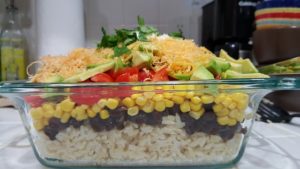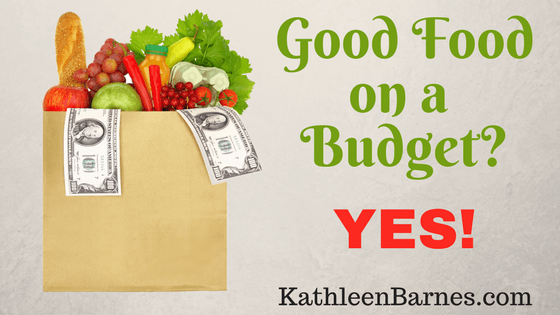Updated: November 10, 2017 – This article originally appeared in Natural Awakenings Magazine.
In case you haven’t noticed, food prices are climbing steadily. I get sticker shock every week at my local supermarket.
We’re all been financially squeezed from time to time and some of us have really been rocked by the economic downturn, perhaps loss of jobs or grown children (and grandkids) moving back home.
So how to we feed ourselves and perhaps even additional mouths in our households on a tight budget?
The Environmental Working Group (EWG) recently issued a booklet that helps consumers get the most bang for their bucks nutritionally.
The booklet, Good Food on a Tight Budget, offers solid ways to feed one person on about $200 a month.
“We really wanted to help people get beyond the common perception that eating healthy is expensive,” says Dawn Underraga, MSRD, EWG’s nutritionist and co-author of the guide.
The EWG, author of the now-famous Dirty Dozen and Clean Fifteen lists
took a close look at 1,200 foods.
“We looked at food prices, nutrients, pesticides, environmental pollutants and artificial ingredients,” says Underraga. “Then we chose the top 100 or so based on balance of all those factors.”
Not surprisingly, Underraga and her colleagues found that highly processed foods likes meals in a box or cereals were expensive and had inferior nutritional value.
Thinking outside the box
Some of the EWG’s findings were surprising:
- Raw cabbage is top ranked because of its high quality nutritional value as a cruciferous vegetable as well as its price. For less than 10 cents a serving, it’s cheaper more nutritious and more calorie-wise even than potatoes and is a good addition to salads, soups and stir-fries.
- The highest marks for nutrition and price went to carrots, bananas, pears, watermelon and frozen broccoli, each at less than 30 cents a serving.
- Bananas, nectarines and pears are usually cheaper than apples and have fewer pesticides applied during the growing process.
- Best animal protein: roasted turkey. Hotdogs, often a mainstay for those on tight budget, ranked dead last.
- Next best animal protein: a whole chicken, roasted at the beginning of the week and used in a wide variety of ways for future meals.
- Fresh foods, like carrots and sweet potatoes and white potatoes are often the cheapest, while frozen corn and broccoli are almost always cheaper than fresh and are nutritionally equivalent.
- A serving of oatmeal is half the cost of sugary processed cereals and it’s more filling and causes fewer blood sugar swings.
- Canned salmon is almost always wild caught and is much cheaper than fresh.
- Queso blanco, a mild soft white cheese common in Latino cooking, is cheaper and less processed than other cheeses.
The guide also includes easy recipes and buying tips.
The Dirty Dozen
The EWG has also issued a list of the most pesticide laden fruits and vegetables. It’s not necessary to buy everything organic. If you can manage organic versions of the Dirty Dozen or even avoid them, your budget won’t take a heavy hit.
Here are the ones to avoid unless they’re organic:
- Apples
- Peaches
- Nectarines
- Strawberries
- Grapes
- Celery
- Spinach
- Sweet bell peppers
- Cucumbers
- Cherry tomatoes
- Snap peas (imported)
- Potatoes
Changing the way we think
Tracie McMillan, Ann Arbor, MI based author of the best-seller, The American Way of Eating, learned the tricks of eating on a very tight budget while she was working undercover as a farm laborer in California, in the produce department of a giant superstore in Michigan and in the kitchen of a restaurant chain in New York.
She had no wiggle room at all when it came to feeding herself, which became even more difficult because she was committed to healthy eating as part of her strategy to stay healthy and be able to work in low-paying jobs.
“The thing I hadn’t grappled with fully was how time and energy are key ingredients when cooking from scratch,” says McMillan. “Let’s face it, I was exhausted after these physically demanding jobs and I became much more apathetic about healthy food very quickly.”
The other side of the “time” coin for McMillan was that there wasn’t a spare dollar for a fast-food burger or a pizza. Cooking from scratch was mandatory, so she learned how.
McMillan learned to soak beans overnight, cook a large pot and freeze the cooked beans for later. The cost: about 50 cents a serving compared to $3 for a can of beans.
Eggs, rice and sweet potatoes were an important—and healthy– part of her diet.
She also found a long-lasting affection for roasted vegetables, not only as part of a meal, but as snacks: “I just cut up a couple of sweet potatoes, add some broccoli or beans or whatever is cheap at the supermarket or farmer’s market, toss in a tablespoon of olive oil and I’ve got food for two or three days.”
“I also learned to use meat more as a seasoning than as a main course,” says McMillan, who confesses that a strip or two of bacon made many dishes much more palatable in her quest for cheap, interesting and healthy food.
Read more from Kathleen on health eating and drinking!








Many thanks for your always very interesting articles!